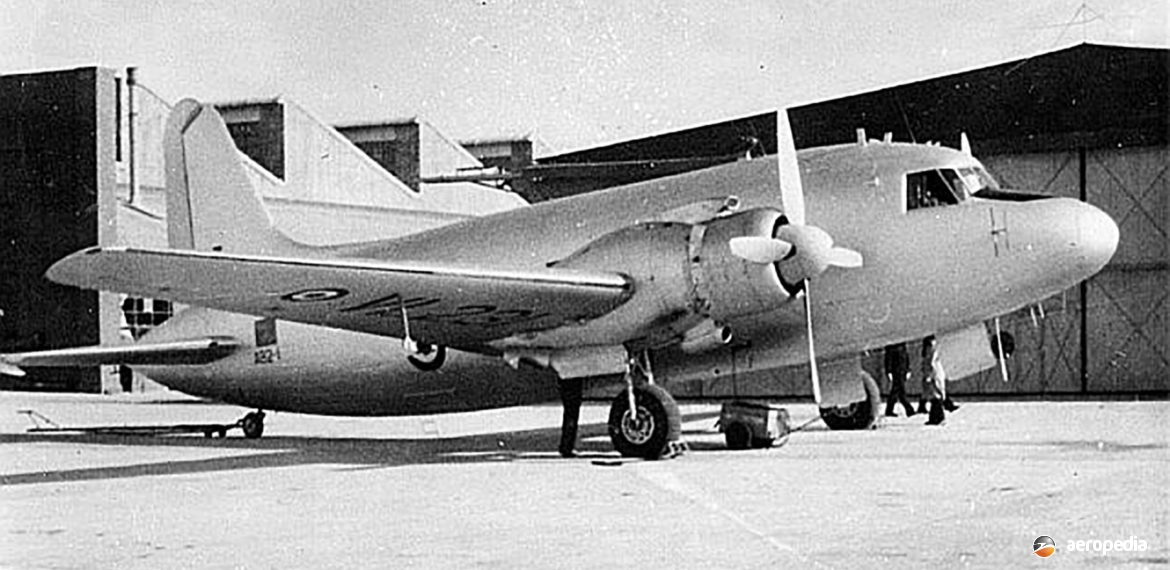Photograph:
Vickers Viking A82-1 (c/n 150) at RAAF Laverton, WA c. 1950 (RAAF Museum)
Country of origin:
United Kingdom
Description:
Civil airliner / military transport
Power Plant:
Two 1,261 kw (1,690 hp) Bristol Hercules 634 fourteen-cylinder two-row sleeve-valve air-cooled radial engines
Specifications:
- Wingspan: 27.21 m (89 ft 3 in)
- Length: 19.9 m (65 ft 4 in)
- Height: 5.94 m (19 ft 6 in)
- Wing area: 82.03 m² (883 sq ft)
- Max speed: 406 km/h (252 mph)
- Cruising speed at 1,829 m (6,000 ft): 310 km/h (193 mph)
- Take-off speed: 204 km/h (127 mph)
- Service ceiling: 6,858 m (22,500 ft)
- Max range: 2,607 km (1,620 miles)
- Range with max payload: 837 km (520 miles)
- Empty weight: 11,340 kg (25,000 lb)
- Max payload: 3,284 kg (7,240 lb)
- Loaded weight: 15,422 kg (34,000 lb)
History:
In October 1944 the British Ministry of Aircraft Production issued a specification for a short/medium haul airliner and Vickers produced the Viking, the first of three prototypes (G-AGOK), designated the Type 491, being flown on 22 June 1945 at Wisley in Surrey. The second (VX238) went to the Royal Aircraft Establishment at Farnborough in Hampshire, and the third (G-AGOM) to the Development Flight of BOAC, flying for the first time on 19 November 1945. First production model was the Mk 1A, some 19 being built, and these were followed by the Mk 1B, which had the fuselage lengthened by 0.71 m (28 inches) increasing passenger capacity from 21 to 24, later 27. A total of 163 Vikings was built. In addition 263 examples of the military variant, known as the Valetta, were built; and 163 examples of the Varsity, a twin-engined military trainer variant with a tricycle undercarriage, were produced.
In April 1947 a Type 636 Mk IB Viking demonstrator G-AJJN (c/n 289) made a sales tour of Australia and New Zealand. This aircraft was the only Viking 1B Type 636 built and was the Company demonstrator. It left Hurn airport in Dorset on 13 April 1947, reaching Auckland on 28 April, and was demonstrated to a number of airlines in 12 countries. By the time it returned to Hurn on 15 June it had travelled 46,808 km (29,085 miles). This aircraft was later converted to Type 610 configuration for BEA and fitted out with 36 to 38 seats and named Charles Napier. In December 1954 it was sold to BKS Transport and, named Jim Mollison, eventually being retired in 1962 when operating with Channel Airways.
One Viking serial VL231 (c/n 150) saw service with the RAAF. This aircraft was first flown on 19 August 1947 and was attached to RAAF ARDU on 14 November that year. It was then (as A82-1) allotted to No 2 (Comm) Squadron. It was damaged by strong winds shortly after and was repaired at Parafield, SA. During 1948 – 1949 it was used by No 34 Squadron on communications duties; and in 1950 was allotted to No 1 AD. It later again went to No 34 (ST) Flight operating from Edinburgh to Woomera in South Australia carrying freight and passengers. It flew 814 hours in RAAF service before being handed back to the RAF on 8 April 1952. It had a number of civil operators thereafter in the United Kingdom and Germany, carrying the registrations G-AOCH, D-AMOR, D-BONA, D-BABY and again G-AOCH.
BOAC came into existence on 24 November 1939 but after World War II BEA was formed to operate scheduled services to and from Europe and within the United Kingdom. Eight Vikings, which had been on loan to BOAC, were handed over to BEA and were operated from Northolt in Greatger London, the first service being G-AHOP (c/n 117) to Copenhagen, Denmark on 1 September 1947. Four Vikings were used by the RAF Kings Flight for the Royal Tour of South Africa (VL245 to 248), two were supplied to the British Ministry of Supply, and 20 to the Argentine Government.
The Viking saw extensive civil service with BEA, with 73 Vikings being taken into service. Five of these later went to South Africa. One Viking, a Type 618 (VX856 – c/ n 207 – G-AJPH), was used to test the Nene jet engine. A few examples of the series survive. One (G-AHOT, ZS-OKH) is held by the South African Airways Museum.

